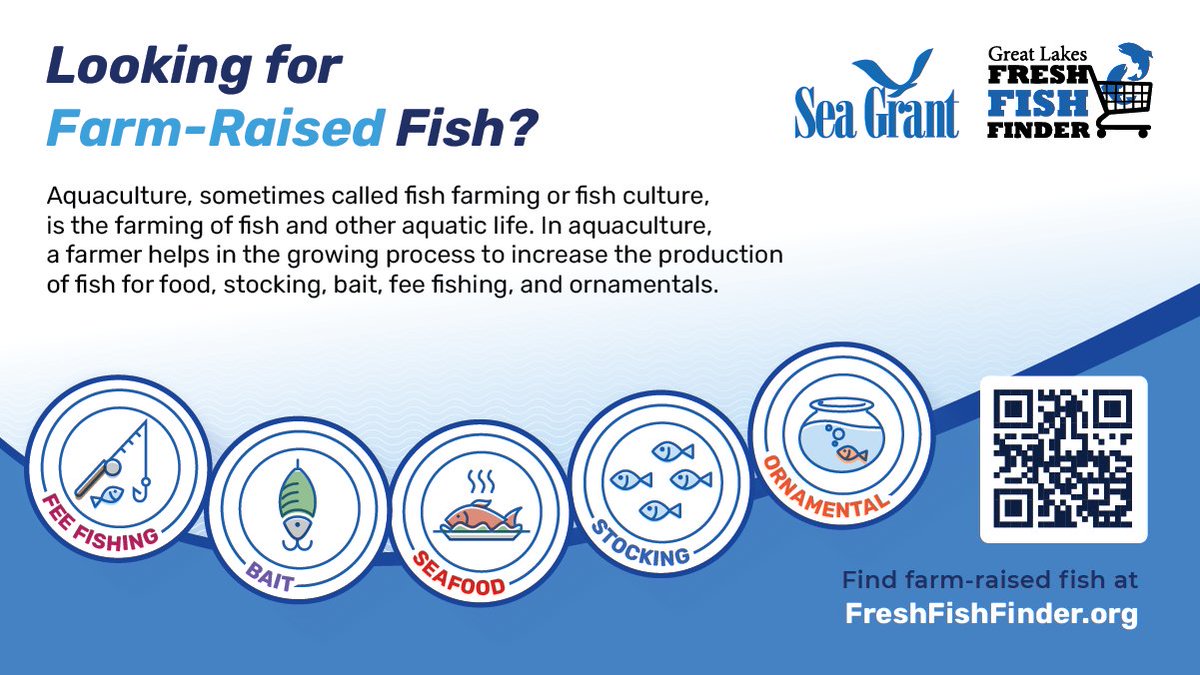December 8th, 2023 by Angela Archer
The Illinois-Indiana Sea Grant (IISG) Summer Internship Program provides undergraduate students opportunities to help address issues impacting coastal communities by combining social and environmental conservation sciences. Through this program, IISG’s interns will gain knowledge and skills in practices that help Lake Michigan coastal communities make more informed decisions about resource management and everyday activities. These paid internships may include research, communications, and/or outreach activities. Applicants may have the opportunity to participate in activities (e.g., attending a professional conference) outside of their specific internship duties.
In 2024, IISG is hiring an intern in each of the following five areas:
- Aquatic Invasive Species Education
- Green Stormwater Infrastructure
- Sustainable Communities
- Water Affordability
- Youth Education
As part of the intern program, IISG includes required professional development trainings. Throughout their employment, the interns will participate in these opportunities, which will add up to approximately eight hours, or one hour per week; some sessions may take more than an hour, so in some weeks, no training will be offered.
For detailed information on position descriptions, hourly pay, and the application process, visit the IISG Summer Internship page. For other questions, contact Angela Archer at amcbride@purdue.edu.
Application packets are due by February 5, 2024, 11:59 p.m. ET.
Illinois-Indiana Sea Grant is a partnership between NOAA, University of Illinois Extension, and Purdue University Forestry and Natural Resources, bringing science together with communities for solutions that work. Sea Grant is a network of 34 science, education and outreach programs located in every coastal and Great Lakes state, Lake Champlain, Puerto Rico and Guam.
December 13th, 2022 by Angela Archer
The Illinois-Indiana Sea Grant (IISG) Summer Internship Program provides undergraduate students from around the country the paid opportunity to combine social and environmental conservation science to help address issues impacting coastal communities throughout the Great Lakes. Each year, a diversity of students gain hands-on experience under the mentorship of a career professional. Skills gained cover a variety of practices in research, communication, and outreach that can help lead to Lake Michigan coastal communities making more informed decisions about resource management and everyday activities.
2023 summer internships are available in the following areas:
- Aquatic Invasive Species
- Great Lakes Education
- Pollution Prevention
- Stormwater Infrastructure
- Sustainable Communities
- Virtual Reality Development
- Workforce Development
As part of the internship, IISG provides professional development trainings over the course of the summer — about one hour each week. The trainings cover topics such as career pathways in natural resources, creating a 60-second elevator speech, and how to use social media as a professional. Successful applicants also have the opportunity to participate in activities (e.g., attending a professional conference) outside of their specific internship duties.
For detailed information on position descriptions, hourly pay, and the application process, visit the IISG Summer Internship page. For questions related to the program, please contact Angela Archer at amcbride@purdue.edu. Application packets are due on February 6, 2023.
Illinois-Indiana Sea Grant is a partnership between NOAA, University of Illinois Extension, and Purdue University Forestry and Natural Resources, bringing science together with communities for solutions that work. Sea Grant is a network of 34 science, education and outreach programs located in every coastal and Great Lakes state, Lake Champlain, Puerto Rico and Guam.
August 9th, 2018 by IISG
Victoria Wallace is interning with Illinois-Indiana Sea Grant (IISG) as a recent graduate of the University of Illinois at Urbana-Champaign with a B.S. in Integrative Biology and a B.A. in Global Studies.
Laying a foundation
On the first day of my internship, I brought a suitcase to work. I was leaving Champaign-Urbana that afternoon to begin a weeklong journey traveling up and down the western coast of Lake Michigan, from Chicago to Sheboygan to Milwaukee. The main event was the 2018 Great Lakes Areas of Concern Conference, held this year in Sheboygan, which was to be an immersive introduction to the themes and issues addressed during my internship.
The next morning, my new supervisor, Caitie Nigrelli, trotted me around the U.S. EPA office in Chicago, introducing me to her colleagues. It was the beginning of a whirlwind week of introductions, and I had to quickly learn to explain who I was and how my work would be relevant to a world I’d only just entered. A world, I came to learn, that was ruled by acronyms.
It quickly became hard for me to explain my internship to friends and family without clarifying at least three or four acronyms—shorthand used so ubiquitously by a small sphere of professionals that they often forget how foreign the strings of letters are to laypeople. And I was not much different when I arrived at this bustling conference in Sheboygan. Even though I studied biology and had been involved in research on aquatic invasive species in the Great Lakes as an undergraduate at the University of the Illinois, I had never heard anyone talk about the Areas of Concern. That morning in the EPA office, I even asked a project manager what “AOC” stands for, unaware of just how green I was.
Learning about Areas of Concern
Over the course of my internship, I have come to see this world with much greater clarity, gaining familiarity not just with the terminology, but with many of the people who undertake these massive projects. The Areas of Concern (AOCs for short) are geographic areas, usually rivers and estuaries, throughout the Great Lakes that have undergone serious environmental degradation. Most of them have suffered historically from industrial and municipal pollution, often leaving behind a legacy of sediments containing toxic concentrations of substances such as PCBs, PAHs and heavy metals.
Because of their industrial histories and gradual degradation, the AOCs are also often some of the most economically depressed areas in the region. The list of AOC communities reads almost like a roll call of rust belt cities: Cleveland, Ohio; Detroit, Mich.; Milwaukee, Wis.; Buffalo, N.Y.; Erie, Pa.; and Gary, Ind., all lie near or within Areas of Concern. And that’s just six of the 43 AOCs.

New restaurants, shops, condos and boat slips line the Sheboygan River.
One of those 43 is the Sheboygan River AOC, a location specifically chosen for the conference not because of the extent of its blight, but for the significance of its transformation. New development, an active harbor and a slew of recreational opportunities are a testament to the work of the AOC specialists—and to the social value of restoring a degraded resource. This is the final chapter of AOC restoration, when the community regains access to a waterfront it had turned its back on, sees its beauty and its potential, and adopts practices that promote its long-term health.
Looking forward
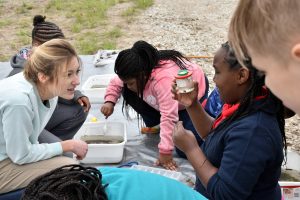
Wallace helped fourth grade students from East Chicago, Ind. discover the oddities and marvels of nature at the Grand Calumet Stewardship Day at a macroinvertebrate station.
After the crucible that was the AOC conference, I went on to see the Milwaukee Estuary AOC, helped facilitate a stewardship event in the Grand Calumet River AOC, and toured two sites in the infamous Cuyahoga River AOC. I’ve also produced outreach materials for the Muskegon Lake and St. Louis River AOCs. Most importantly, I’ve worked with Caitie to design a research project to better understand the social transformation after the remediation and restoration work is done. It’s being dubbed “revitalization” in the AOC world, and it’s changing how we think about environmental restoration.
If restoring a river can revitalize a community, what does that mean for the future of the Great Lakes? Can the history of exploitation be replaced with a narrative of stewardship, growth, and mutual benefit? I think that there’s a chance it can, but there needs to be a concerted effort. The research I’ve helped develop will push things in that direction by asking the AOC world to confront the question, “Who are we doing all of this for?” And, as a newly-minted environmental scientist, that’s certainly a question I’ll keep in mind as my career develops and matures.
Learn more about our internship opportunities online, or contact Angie Archer at (765)496-3722, amcbride@purdue.edu.
Illinois-Indiana Sea Grant is a part of University of Illinois Extension and Purdue University Extension.
June 26th, 2018 by Sarah Zack
Gillian Flippo is interning with Illinois-Indiana Sea Grant (IISG) as a recent graduate of Butler University with a bachelor’s degree in Science, Technology and Society.
I am a native of Chicago, and working for the health of my local environment and community is of great interest to me. As an intern for the IISG pollution prevention team led by Sarah Zack, I was fortunate to attend the 2018 Emerging Contaminants in the Aquatic Environment Conference (ECAEC), held June 5-6 in Champaign, IL. Newly developed chemicals and substances are used to improve processes and products; however, they often have unintended consequences on human and environmental health, which is why they are of emerging concern. Regardless of whether these contaminants are old or new, many brilliant minds are working to understand their effects, how they move through the ecosystem and how to properly prevent and remove them. At ECAEC, I witnessed these minds come together. Organized by the Illinois Sustainable Technology Center and Illinois-Indiana Sea Grant, the conference covered many important topics related to emerging contaminants over the course of two days.
A Widespread Problem
Keynote speaker Rainer Lohmann, a professor at the University of Rhode Island, studies the transport, fate and bioaccumulation of persistent contaminants. His findings demonstrated that these contaminants are not only found at the sites where they are being released. Through various methods such as the movement of water by ocean currents, the contaminants spread to some of the most remote places on earth.
These places that were once thought to be pristine, like the Arctic, are also feeling the effects of these potentially damaging chemicals. I learned that part of the reason these contaminants are found around the globe is because wastewater treatment plants aren’t designed to remove many pharmaceuticals and personal care products (PPCPs). Therefore, they are released into nearby streams and rivers, which eventually make it to the ocean.
Mitigation and Prevention
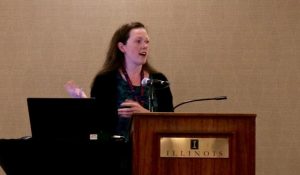
Alison Franklin, PhD student at Penn State, speaks at the 2018 Emerging Contaminants in the Aquatic Environment Conference.
Fortunately, there are scientists like Alison Franklin from Pennsylvania State University, who are researching ways to mitigate the emerging contaminants released from wastewater treatment plants. Her research demonstrates the possibility of using soil as a natural filter to improve water quality and protect human health, focusing on antibiotics in wastewater effluent. Her results showed that groundwater concentrations of antibiotics were lower than the wastewater effluent concentration after being filtered through soil. This suggests that soil may be an adequate third step in wastewater treatment. I found this interesting because the process uses part of nature as a partner to help combat environmental challenges like emerging contaminants.
A wide variety of professionals attended the ECAEC, providing a multi-disciplinary approach to solving the problem of emerging contaminants. Jill Bartolotta from Ohio Sea Grant offered an interesting perspective on the issue, focusing on single-use plastic and the underlying behavioral barriers that inhibit people from using reusables. Her study sought to tackle the problem from the source so that plastic is prevented from getting in waterways in the first place. One interesting piece that caught my attention was that Bartolotta’s survey results showed that people have enough reusable bags, but they forget to bring them to the store. Therefore, people don’t need more reusable bags but instead need new ways to be reminded to use them. This shows that we need to dig deeper to find a new approach to tackle the problem of single-use plastic.
Takeaways
Bartolotta’s talk especially captivated me because it was relevant to my interests in engaging the public on environmental issues. For PPCPs and other emerging contaminants like plastic, it is important to understand the real source of pollution: people and their practices. People may unknowingly pollute because they are simply unaware that what they are doing is wrong, which is why education is important. Or there may be behavioral barriers and incentives that lead people away from environmentally sustainable options, which is why understanding the underlying causes and thinking of alternative solutions are important.
It was incredibly eye-opening to see the research and effort that is being put into tackling the issue of emerging contaminants in the aquatic environment. It became obvious to me after listening to the conference speakers that this issue needs input from many disciplines for us to truly understand and solve the problem. Despite the size and complexity of the issue, it made me feel hopeful to know that it has the potential to be fixed. The conference was great to experience in the beginning of my internship because it helped me understand the work and research going into understanding the issue of emerging contaminants, while challenging me to think of effective ways to communicate the problems to the public.
March 8th, 2018 by Sea Grant
Illinois-Indiana Sea Grant announces the following positions for the 2018 Summer Student Internship Program. Successful applicants will spend 12 weeks working closely with a Sea Grant specialist on issues affecting the Great Lakes. Internships can include research, communications, and outreach components. Applicants may also have the opportunity to participate in activities outside of their specific internship duties. For more information visit http://www.iiseagrant.org/internship.php
Internships, open to undergraduates, are available in the following areas:
Aquaculture Product Development
Great Lakes Revitalization
Lake Michigan Fisheries Genomics
Pollution Prevention
Sustainable Communities
All inquiries should be directed to Angela Archer, IISG fellowship program leader, amcbride@purdue.edu, Purdue University, 765-496-3722.
Illinois-Indiana Sea Grant is a part of Purdue Extension and University of Illinois Extension
June 26th, 2017 by IISG
I’m aboard a 180-foot research vessel traversing Lake Huron; the ship is the U.S. EPA R/V Lake Guardian, and the goal is to take the pulse of this gaping freshwater entity. Every year the Cooperative Science and Monitoring Initiative (CSMI) comprehensively surveys one of the five Great Lakes. As a result, it’s been five years since we’ve taken a long look at Lake Huron.
Those working on this particular six-day research cruise vary from marine technicians who live on the ship for the whole sampling season, to scientists from the U.S. Environmental Protection Agency (EPA) and U.S. Geological Survey (USGS) onboard for the week to collect data and bring it back to their labs.

Left: A larval fish seen under a microscope. Right: The trawl net used to sample larval fish being pulled in over the sunrise.
And me?
I’m here with IISG as the Great Lakes communication and outreach intern, helping out with the sampling and observing so that when I’m back on land, I can use this experience to enhance my translations of scientific studies from the 2015 CSMI survey of Lake Michigan to engaging, accessible outreach materials for policy makers, fisheries managers, and the general public.

Clark working on the fantail.
I am on the 4 a.m. to 4 p.m. shift of this around-the-clock undertaking. At 3:30 a.m., I’ve got to hastily get up and shuffle down the hall to relieve the night shift on the back deck. I pull on my rain boots, life jacket, and hardhat, then grab a clipboard to record the samples as they come in. There are six sampling sites to complete on this cruise, and each composes a “transect,” a narrow section of water which runs perpendicular to the shoreline, providing an offshore, mid-shore, and nearshore snapshot.
Each station has a sampling agenda. If a station is reached at night, this protocol begins by sampling benthic, shrimp-like animals known as Mysis under red light. If the sun has already risen, we use an extremely large and well-outfitted CTD—an instrument that measures conductivity, temperature, and depth as it is deployed through the water column.
Next up is the zooplankton sampling, followed by two ichthyoplankton tows to sample larval fishes—the early stage in a fish’s life history where they are mere millimeters in length, floating about eating the zooplankton we sampled just prior. The larval fish collected are separated from the various bycatch of flotsam and examined back at USGS headquarters for a variety of parameters including species, length, and age.
The age data, collected by examining growth increments on the larvae’s minute otoliths (inner ear bones), is reported in days old. I find them enormously cute, in an E.T.-without-legs kind of a way.
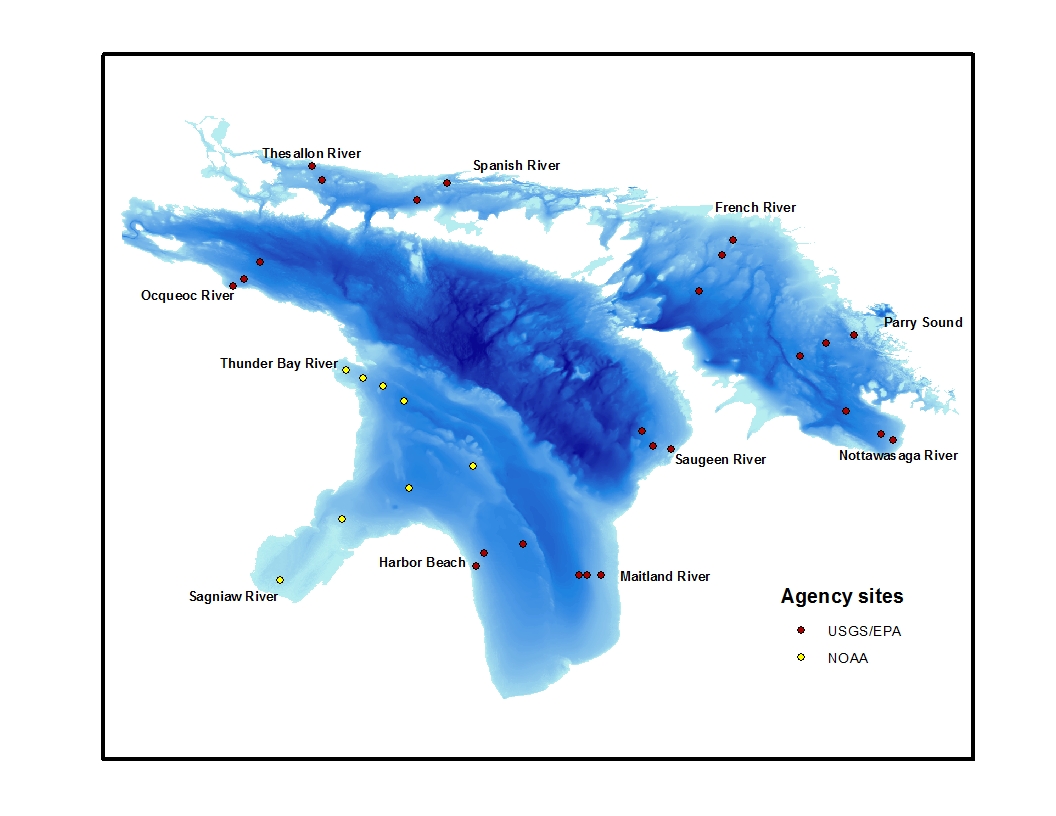
Map of the CSMI survey stations in Lake Huron. During this cruise Harbor Beach, Maitland River, Saugeen River, Nottawasaga River, Parry Sound, and French River transects were sampled, in that order.
After each of the three stations have been surveyed, a large sampling instrument called the Triaxus is towed back along the entire transect to gather information across the full survey area. Depending on the length of the transect, this can take a while.
I have found this a great time to hit the galley and grab a second or third breakfast, depending on the day. After all, by 9 a.m. I’ve been awake for a good five to six hours and there’s more sampling to do.
We then lower the Rosette, a big water sample collector, to measure the amount of chlorophyll in the water. We also put nets down six different times to collect zooplankton. We then used a big net to collect larval fish out the side or behind at different depths throughout the water column. We also towed the Triaxus for a few hours. We head to the next transect and do it all over again.
And—if we’re lucky—in exchange for all our hard work, the next time I crawl out of my bunk at 3 in the morning I get to witness a scene like this one:
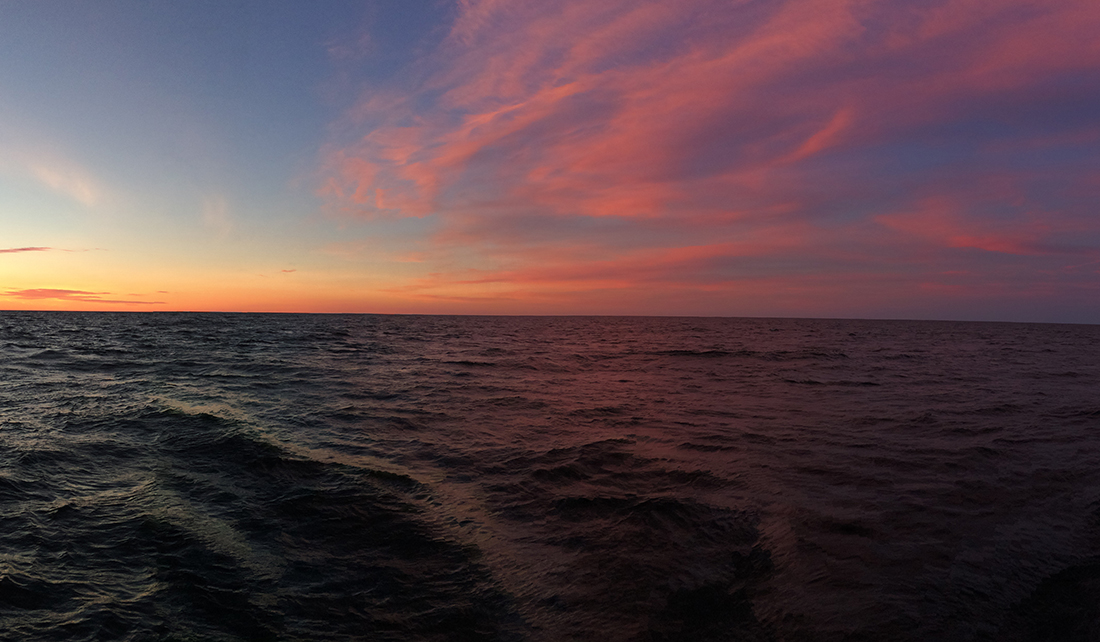
Emily Clark is working with Paris Collingsworth and Kristin TePas as a summer intern with IISG where she is creating outreach materials for the results of the 2015 Lake Michigan CSMI field year. Clark is a student at College of Charleston in South Carolina studying biology, environmental studies, and studio art.
Illinois-Indiana Sea Grant is a part of University of Illinois Extension and Purdue University Extension.
June 9th, 2017 by IISG
IISG and Illinois Water Resources Center extend a big welcome to this summer’s interns! The five will be working side-by-side with specialists and scientists on everything from outreach and communication to sample collection and data analysis.
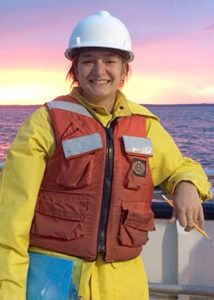
Emily Clark
Illinois-Indiana Great Lakes Communication and Outreach Intern
Paris Collingsworth and Kristin TePas
Emily Clark is going into her senior year at the College of Charleston in South Carolina. At College of Charleston Clark she is a biology major with minors in environmental and sustainability studies and studio art. She has strong interests in aquatic ecology and science communication, which is what led her to apply to this internship.
As the Illinois-Indiana Great Lakes communication and outreach intern working in the Chicago area, she will be learning about the results of the CSMI field year in Lake Michigan from 2015. She is reading the studies that were done, and will be interviewing scientists on their work. Following this research, Clark will be putting together outreach materials for a variety of managers and policy makers to ensure the changes in the lake are taken into consideration. In addition, she will be participating in this year’s CSMI research cruises on Lake Huron helping to collect contemporary data on the Lake.
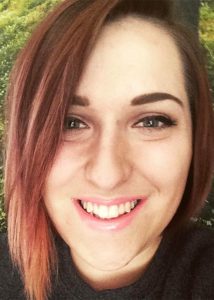 Lindsey Dice
Lindsey Dice
Fisheries Data Analyst Intern
Mitch Zischke and Tomas Höök
Lindsey Dice is a junior fisheries and aquatic sciences major and Spanish minor at Purdue University. She is a fisheries data analyst with Illinois-Indiana Sea Grant this summer and will be working with charter boats in Lake Michigan to update the Lake Michigan Fish Catch on the IISG website.
Dice will also be analyzing data collected from inland glacial lakes. She will be comparing the relationship between water quality and total catchment area.
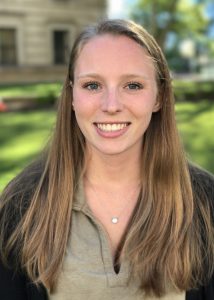 Madeline Henschel
Madeline Henschel
Sustainable Communities Intern
Kara Salazar and Daniel Walker
Madeline Henschel be a senior this fall at Loyola University Chicago and is an environmental studies major with a minor in finance. She spent the fall semester of her junior year studying abroad in Australia where she had the opportunity to study environmental management and marine biology. She has also worked with a small neighborhood and business development group in Chicago on a local farmers market that emphasizes the availability of fresh food for shoppers with federal or state nutritional assistance.
Moving forward, Henschel hopes to focus her career on sustainability and the many forms it takes. This summer as the Sustainable Communities intern she will be contributing to case studies for Enhancing the Value of Public Spaces Program, collaborating with the Lake Michigan Coastal Program to create a coastal flooding tool kit for municipalities, as well as support the Extension program by traveling the state attending meetings and community programs.
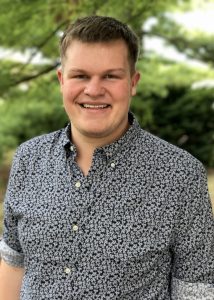 Cameron Letterly
Cameron Letterly
Illinois Water Resources Intern
Eliana Brown
Cameron Letterly is a summer intern with the Illinois Water Resources Center (IWRC) where he is currently working on several projects, including graphics for the Nutrient Loss Reduction Strategy in coordination with Illinois-Indiana Sea Grant, revitalization of a university rain garden, and work regarding green infrastructure and real estate value.
Cameron joins IWRC as a student in the Master of Landscape Architecture program at the University of Illinois at Urbana-Champaign as well as a prospective Illinois MBA candidate.
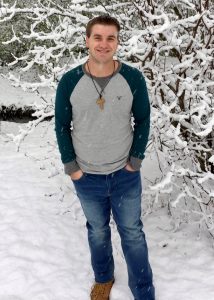 Brandon Stieve
Brandon Stieve
Microplastics Research Intern
Leslie Dorworth and Sarah Zack
Brandon Stieve is a chemistry major, with an environmental science minor, at Purdue University Northwest and expects to graduate in the spring of 2018, after that he looks to start his career. Stieve’s dream job is to be at an environmental testing corporation, studying water toxicity and use that information to help protect the health and well-being of people. He think the area he wants to specialize in is metal toxicity in waterways.
His research project is looking at microplastic concentration in lakes and streams of northwest Indiana. He is working with Kathryn Rowberg, Leslie Dorworth, Sarah Zack, as well as another student, Josh Miranda.
Illinois-Indiana Sea Grant is a part of University of Illinois Extension and Purdue University Extension.
July 26th, 2016 by IISG
When I started working at the Illinois Water Resources Center in May, I had no idea what kind of summer I had signed up for. Needless to say, I hit the ground running. On my third day, we traveled to Chicago for an overnight meeting with IISG, and other state agencies. We discussed current issues, future plans, plus introduced new employees, and interns, like myself. In an unfamiliar place with new people and environmental issues new to my knowledge, I was welcomed warmly, and always encouraged to express my thoughts and opinions.
Next, a rainy Memorial Day weekend came, and with a newfound perspective of water’s role, I traveled across the state to Quincy, Illinois to visit my grandmother. Without having to do much searching, water’s effects were all around me during the trip—the green grass, beautiful flowers, wildlife, woods, and bluffs near the Illinois, and Mississippi rivers. Feeling refreshed, I started diligently planning and working on the blog for the summer. I researched, and wrote my first post on the Fox River in northern Illinois, which seemed appropriate given my recent trip to Chicago. I also went to several video shoots for various outreach projects.
I later attended the Agriculture Water Quality Partnership Forum tech-subgroup meeting in Springfield, as well as the Nutrient Management Council meeting in Champaign. The Illinois Nutrient Loss Reduction Strategy—something I studied in my agriculture classes—was put into action as the different agencies, and organizations worked together. In contrast, I then had the privilege of interviewing my dad about what conservation practices he implements on our family farm. It was amazing to not only first-hand explore these issues, but to apply, and build upon concepts I previously studied.
As someone with a strong agricultural and farm background, I realize the importance of sustaining land, wildlife, and of course, the human population. As increasingly more people move to urban environments, and are further removed from agriculture, education will only continue to be more important. I cannot wait to start my senior year at Illinois State University, apply to graduate schools, and pursue a career in natural resources as well as environmental and agriculture education. I am extremely grateful for the opportunities the Illinois Water Resources Center has given me, and even more so, the wonderful people I am fortunate to have worked with.

Ashley, center, helps out the campers with a stormwater workshop earlier this summer in Peoria, Illinois.
Overall, the passion my co-workers have for water related issues is truly inspiring. The wealth of knowledge, and variety of personal and educational experiences creates a very interesting dynamic. I am leaving better versed on nutrient issues, stormwater, green infrastructure, and how all agencies must collaborate to solve problems.
Through teaching an educational STEM camp, interviewing farmers, attending meetings, video shoots, and tweeting I became a better agricultural communicator. Blogging regularly also made me a stronger writer, researcher, and critical thinker. In reality, there is no cut-and-dry answer or formula to solve all environmental issues. It is something we all must work together and compromise on in order to improve, and sustain water resources, and all life that depends on it. No matter where you live, water is something not to take for granted, but to embrace. After all, we would not be here without it.
June 16th, 2015 by iisg_superadmin
By Anne Packard (Anne is a summer intern working with Laura Kammin, IISG pollution prevention specialist)
 Can pharmacists play a role in pollution control? This is the question I asked myself when I heard about an internship through Illinois-Indiana Sea Grant.
Can pharmacists play a role in pollution control? This is the question I asked myself when I heard about an internship through Illinois-Indiana Sea Grant.
As a third year student at Purdue University College of Pharmacy, I became interested in this internship because of my love for the Great Lakes. I am a western Michigan native, so the freshwater lakes are dear to my heart. At a young age, I took advantage of all the benefits living close to Lake Michigan can provide. I have fond memories of sailing, watching the sunset, and building sand castles on the beach.
During the school year, being a pharmacy student feels like a 24 hour a day job. The amount of time spent studying and thinking about pharmacy related topics is quite demanding. I have to love what I study. The pollution prevention internship is a great way for me integrate two key facets of my life—my pharmaceutical knowledge and my love of the environment and the Great Lakes.

My role with Illinois-Indiana Sea Grant is to help with education in the community with regards to medication pollution and disposal. Another major aspect that ties in my pharmacy experience will be to educate people about the consequences for misuse, accidental poisonings and abuse of unused medication. I also am working with a Purdue College of Pharmacy professor to organize data to better understand the needs in the Lafayette area related to medication take back programs.
Even in the few weeks since starting, my knowledge base on medication pollution has expanded substantially. By the end of this summer I hope to take the knowledge I have gained and apply it in my future career as a pharmacist. Through this experience I want to be knowledgeable about the resources available for proper medication disposal as well as tools to implement safe disposal practices wherever my career takes me.
As with all student interns, there is always a dream of making a difference in the job they are in. Although, I do not expect to make groundbreaking changes, I hope I can help my community take a step in the right direction to minimize pharmaceutical pollution in the environment.









 Lindsey Dice
Lindsey Dice Madeline Henschel
Madeline Henschel Cameron Letterly
Cameron Letterly Brandon Stieve
Brandon Stieve

